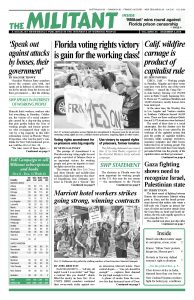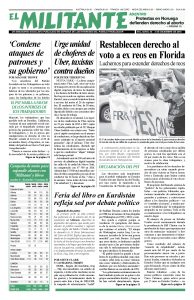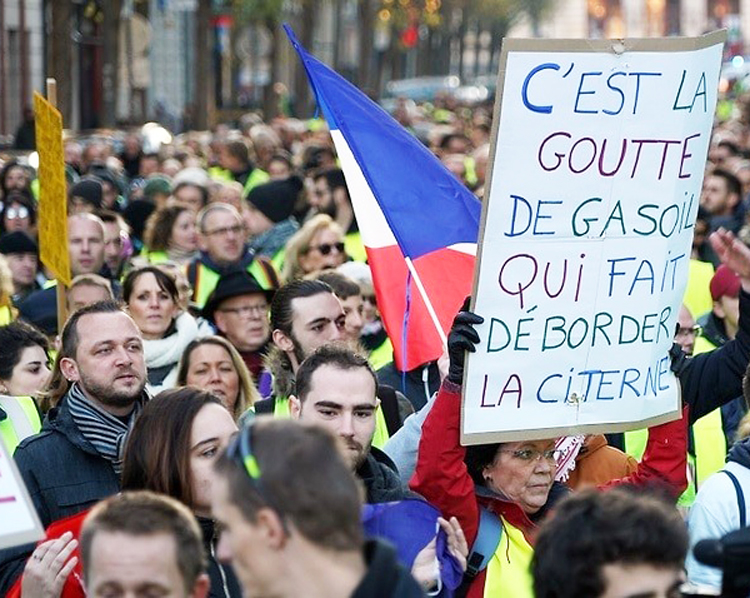Some 280,000 demonstrators took to the streets, especially in smaller towns and more rural areas, in France Nov. 17 to protest rising gasoline taxes that impact workers, self-employed and small farmers the most. Protesters blocked roads with their cars and their bodies at 2,000 locations nationwide, with tens of thousands rallying in support. Actions continued over the next couple of days over the effects of the capitalist economic crisis and expressing declining support for French President Emmanuel Macron’s climate change scheme.
“I earn 500 euros ($570) a month. How do you expect me to live on that?” Jean Luc, 57, who was attending the protest in Calais, told France 24. “With what I earn I can only allow myself one meal a day.”
Macron raised so-called “green taxes” on fuel prices, particularly on diesel, the most commonly used fuel in France. The goal of the tax isn’t to raise money for the government, but to force people to back off driving. Diesel prices over the past year have risen 20 percent and gasoline in Paris costs $7.06 a gallon.
Those living outside of cities, especially in rural areas, depend on their cars to get around, to do chores, and to get to work, often having to drive greater distances. In many of these areas official unemployment remains high — at nearly 10 percent — and rural hospitals have closed, making it necessary to drive longer distances to meet medical needs.
The protests were very popular, backed by 75 percent of those asked in a Nov. 16 poll by Le Figaro.
Increasingly known as the “president for the rich,” Macron has attacked rail workers and fought with the unions over anti-working-class labor “reforms.” His popularity has plummeted, from 39 percent in July to 21 percent in October.
At the action in Paris Nov. 17, police fired tear gas, injuring 227 people — seven seriously. Over the weekend 409 people were injured nationwide and a 63-year-old woman protester killed when hit by a car.
The protesters, broadly known as the “Yellow Vests” after the safety vests they wore, aren’t affiliated with any national organizations. “We are not political people; we do not belong to a union, we are citizens,” Didier Lacombe, a retiree who lives on a fixed income near Éragny, a small town an hour west of Paris, told the New York Times.
The blockade protests grew out of a petition against the tax increases that circulated online and got millions of signatures. “You have persecuted drivers since the day you took office,” white-haired grandmother Jacline Mourand told Macron and his government in a celebrated YouTube video that has been viewed 6 million times. “What do you want with the dough, apart from changing the plates at the Elysée or building yourselves swimming pools?”
The protesters have won support from forces on the right and left of bourgeois politics in France, from the National Rally, the new name of the party of Marine Le Pen, and from France Unbowed’s former presidential candidate Jean-Luc Melanchon.
However, two of the main French trade unions — the General Confederation of Labor and the French Democratic Confederation of Labor — have both come out against the protests on the grounds they included some “fascists.”
Blockades remained in place at about 150 locations Nov. 18 — from Rennes, in western France; to Avignon, in the south. Some 20,000 protesters took part in 350 actions the following day, including on a highway leading to the tunnel used by Eurostar trains to Britain.
Despite the mass actions, French officials insist the gas taxes will remain in place, and increase again in January.
Yellow Vest protesters say they plan to organize further actions.


